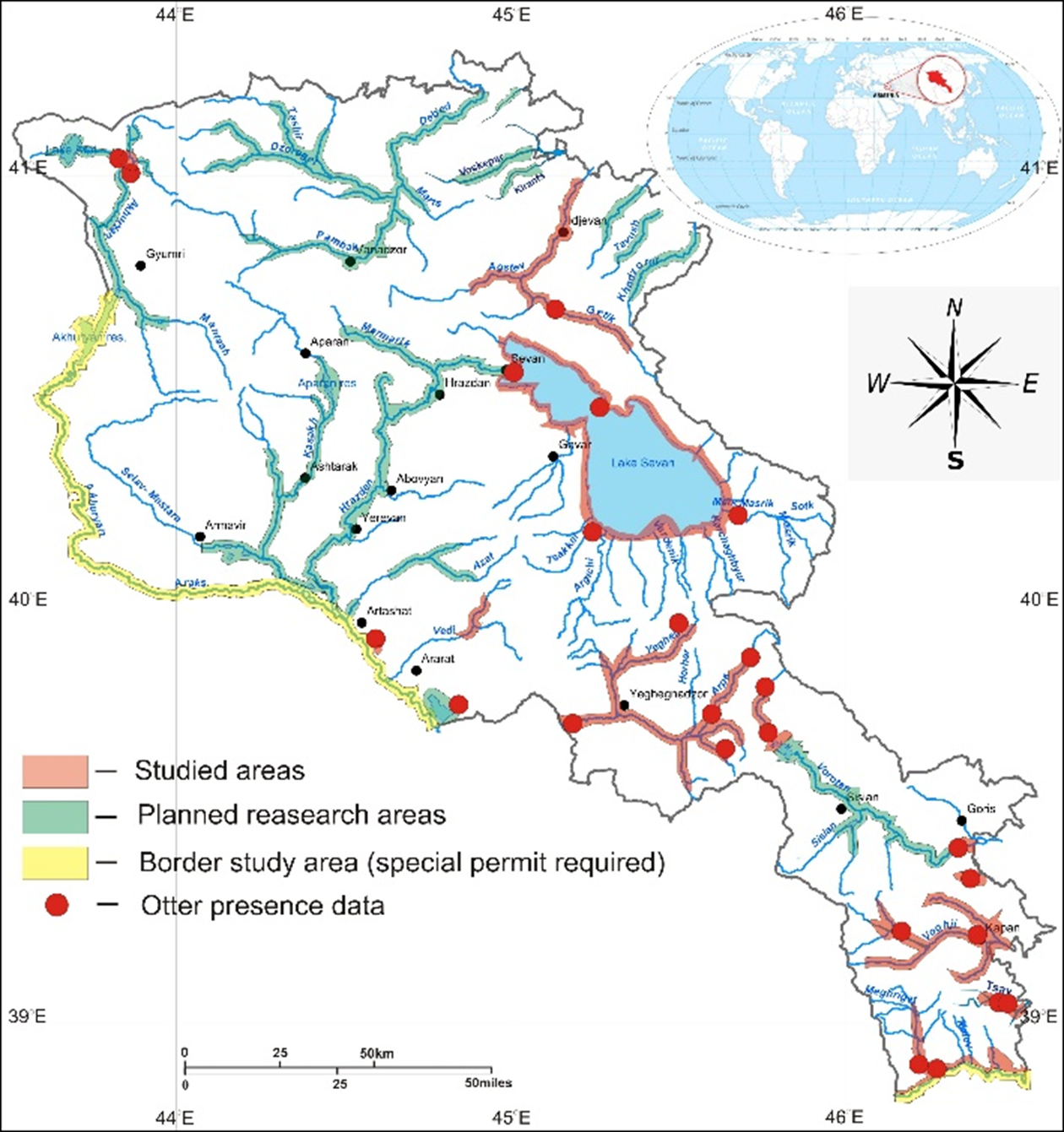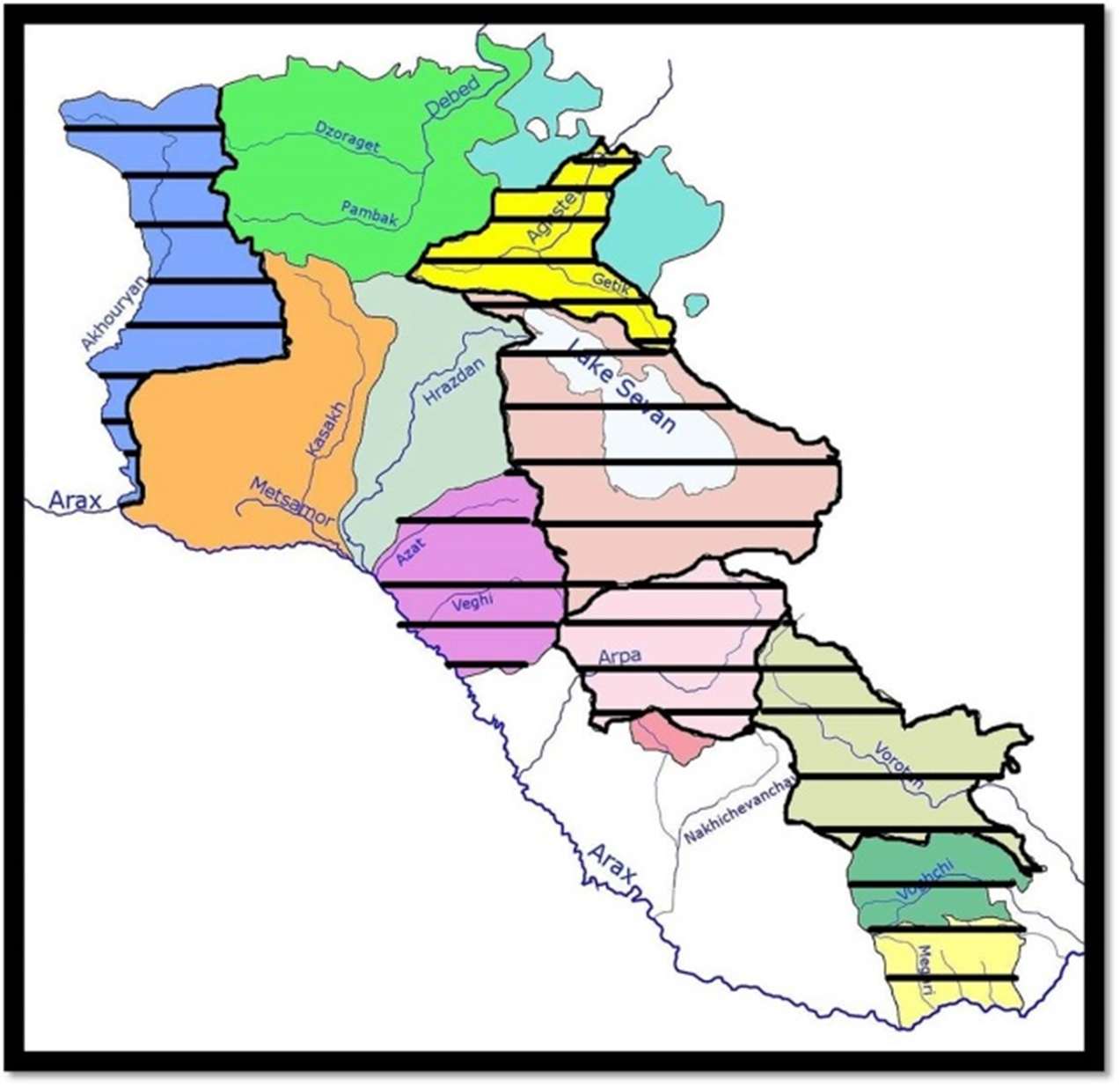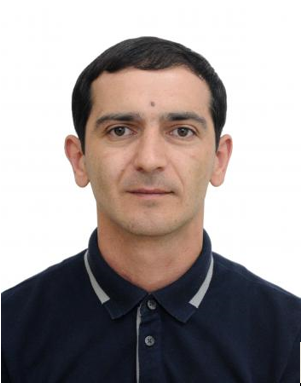IUCN/SSC Otter Specialist Group Bulletin

©IUCN/SCC Otter Specialist Group
Volume 37 Issue 4 (December 2020)
Citation: Buzzard, PJ, Gyonjyan, A, Kaloyan, G and Aghasyan, L. (2020). Update on the Status of the Eurasian Otter Lutra lutra in Armenia IUCN Otter Spec. Group Bull. 37 (4): 196 - 204
Update on the Status of the Eurasian Otter Lutra lutra in Armenia
Paul. J. Buzzard1, 2*, Andranik Gyonjyan3, Gor Kaloyan3, and Levon Aghasyan3, 4
1Detroit Zoological Society
1 China Exploration and Research Society, Southmark, 11 Yip Hing Street; Wang Chuk Hong; Hong Kong, China
3 National Academy of Sciences, Republic of Armenia
4 Ministry of Environment, Republic of Armenia
* Corresponding Author: Email: p_buzzard@yahoo.com
(Received 18th March 2020, accepted 17th May 2020)
Abstract: There is little information on the status of Eurasian otters (Lutra lutra) in most parts of Asia including Armenia where the species is designated as “Endangered” on the Armenian Red List. Otters have declined in Azerbaijan and Iran, which neighbour Armenia, so it is critical to assess otter status in Armenia. To accomplish this, we used sign surveys, interviews and trail camera stations (n=4) on the majority of river systems and major lakes in Armenia. Our results confirmed otter presence in all areas surveyed, suggesting otter recovery, especially in the far northwest, the south-central province of Vayots Dzor and around Lake Sevan in central Armenia. In many areas, conflict is now increasing from otter predation at fish farms, and otters are sometimes killed in response. Fencing and dogs have been used to prevent conflict, and more research is needed to find the most cost-effective ways to mitigate conflict. In addition to otters killed because of conflict, other threats to the otter population include illegal hunting for fur, by-catch in illegal fishing nets and pollution from mining. An otter hotspot was identified in the Arpa River catchment of Vayots Dzor, and future work is necessary in the remaining parts of Armenia to identify more hotspots where conservation efforts can be focused.
Keywords: Eurasian otter; Armenia; Lutra lutra; human-wildlife conflict
INTRODUCTION
The Eurasian otter (Lutra lutra) is classified as Near Threatened on the International Union for Conservation of Nature (IUCN) Red List of Threatened Species (Roos et al., 2015), and they are considered Endangered on the Armenian Red List (Aghasyan and Kalashyan, 2010). There is little information, however, on otter status in most parts of Asia including Armenia, where no comprehensive otter research has been conducted during the last three decades. Trapping and commercial sale of otter fur in the South Caucasus (Armenia, Georgia, and Azerbaijan) started in 1925 (Gorgadze, 2004), and at Armenian fur collection stations, the total number of otter pelts collected per year from 1949 to1959 averaged 60.5 and ranged from 24 to 88 (Aghadjanian, 1986). After this period, there was a rapid decrease in the number of pelts, and from 1969-1978 no otter pelts were recorded at the collection stations. According to Aghadjanian (1986), overhunting for fur, as well as river pollution and habitat destruction contributed to the continuous decline of the species, and by the 1980s, the Eurasian otter was believed to be extinct in Armenia. Moreover, there was a dramatic drop in the water level at the largest lake in Armenia, Lake Sevan, further negatively affecting the otter population (0Red Data book of Armenian Soviet Socialist Republic (SSR), 1987). The otter was not common in Armenia during the 1990s either with only rare sightings across the country (Ghasabyan, 2001).
The Eurasian Otters is rare or declining in the countries that border Armenia. In the South Caucasus fur trade of the early 20th century, most pelts were obtained from the Georgian population (Wereshagin (1959) referenced in Gorgadze, 2004), and by the end of the 1980s, the Georgian population had become fragmented (Kokhodze (1991) referenced in Gorgadze, 2004). Preliminary population assessment studies in different parts of Georgia demonstrated that the otter has already disappeared from many areas or has formed isolated sub-populations (Gorgadze (2001) referenced in Gorgadze, 2004), and the Eurasian otter is on the Red List of Georgia (Oleynikov and Saveljev, 2015). In addition, the most recent otter surveys in Azerbaijan suggest that otter numbers there have declined drastically since the mid 1980s primarily from overhunting and pollution (Kasumova et al., 2009), and overhunting and pollution as well as habitat disturbance also threaten otters across Turkey (Thol-Schmitz, 2004; Ozen and Gunduz, 2015; Uluturk and Yurumez, 2017). The otter has been reported across Iran (Karami et al., 2006), but they have declined recently, especially from the Mesopotamian marshlands and the Anzali wetlands primarily because of pollution and habitat degradation (Mirzaei et al., 2010; Naderi et al., 2017; Mohtasebi and Tabatabaei, 2018). In the Anzali wetlands, otters are also killed for consuming fish at fish farms (Naderi et al., 2017).
It is, thus, crucial to obtain current information on otter distribution and status in the river systems and major lakes of Armenia, so conservation actions can be initiated where most needed. This paper documents otter status and threats using sign surveys for otter faeces (or ‘spraints’), feeding remains and tracks (Reuther et al., 2000; Meleros et al., 2017); trail cameras; and interviews with locals about otter presence and attitudes towards otters. We were able to confirm otter presence in the majority of Armenia’s river systems and document threats to its conservation. In many areas, otter populations seem to be increasing, which has led to increases in otter-human conflict from otters raiding fish farms.
METHODS
The Greater and Lesser Caucasus Mountains create heterogeneous habitats in Armenia, and as a result Armenia is part of the Caucasus Mountains biodiversity hotspot in southwest Asia (Figure 1, Mittermeier et al., 2004). To assess otter status in Armenia, we conducted three week-long expeditions in June and November 2018 as well as May 2019. During expeditions, we conducted sign surveys and open-ended interviews for otter presence in the major rivers and lakes of the drainage basins marked with horizontal lines on Figure 2. We plan to search rivers in all basins as indicated on Figure 1, but this initial work focused on areas where there was prior information on potential otter presence.

In Armenia, the Eurasian otter is the only otter species present, and according to the IUCN Red List of Threatened Species, the American mink (Neovison vison) is not present in Armenia (Reid et al., 2016). To ensure that there was no confusion with other semi-aquatic mammals such as coypu (Myocaster coypu), a rodent native to South America that was introduced to Armenia for fur production around 1940 and now lives in feral populations (ISSG, 2011), we also asked about behaviors characteristic of otters such as piscivorous feeding habits, which was usually relevant because many of the interviewees had fish farms.

Sign surveys for otter tracks, spraints and feeding remains used the IUCN standard method (Reuther et al., 2000; Meleros et al., 2017). The Standard Method involves walking transects of 600 m spaced at least 5 km apart along banks to look for spraints as well as tracks and feeding remains. We searched both sides of rivers when possible to improve the accuracy of the method (Elmeros and Bussenius, 2002) and stopped transects when an otter sign was found. We interviewed a variety of locals about otter presence and attitudes towards otters including National Park Staff, fish farmers, World Wild Fund for Nature (WWF-Armenia) staff, hydropower staff, dam guards, riverside restaurant owners, fishery scientists, and wildlife rangers.
In promising areas for otters, we set five Reconyx Utrafire motion-detecting trail cameras attached to trees, rocks or bridges 0.25-1 m off the ground (Table 1). We considered successive pictures notionally independent if they occurred at least one hour apart (Rovero and Marshall, 2009). In November 2018, we set two cameras in the far northwest Akhuryan River catchment (Figure 1) at Arpi Lake National Park. The cameras were over 3 km apart along the Akhuryan River: one next to otter feeding remains and the other near a likely den at the base of a bridge. At the other three camera sites, we used Caven’s otter lure as an attractant. In October 2018, in the Vorotan River catchment (Figure 1), we set one trail camera near otter feeding remains at a hydropower station upriver of the Spandarian reserve. In June 2018, we set the other two cameras in the Arpa River catchment (Figure 1): one near otter feeding remains near a fish farm in the midsection of the Arpa river and the other near feeding remains on the Arpa River near Areni village.
RESULTS
We found otter presence in every drainage basin we searched, but we do not provide GPS locations to protect the otters (Figs. 1, 2). In the northwest, we visited Arpi Lake National Park. Park staff reported that otters were common at Arpi Lake, and along two stretches of the Akhuryan River over three kilometers apart we found sign of otter feeding remains (fish with just the head eaten) or tracks and feces within the first 50 m of sign surveys. In both areas, we set trail cameras and obtained pictures of otter at both cameras including at least five individual otters (one lone male and a family with four individuals, Table 1).
In November 2018, we found no sign of otters north of Lake Sevan, in the Agasten/Getik Rivers basin. We walked unsuccessful sign surveys around Lake Parz of Dilijan National Park and along Ijevan reservoir. An interview at an Ijevan fish farm and two interviews at Barepat village in Getik valley indicated that otters had probably been hunted out and had not been seen for several years, but several weeks later several students from Dprabak village sent us a picture of otter tracks, which were found along the Getik River bank (Fig. 2 ).
In November 2018, we interviewed rangers at the protection station at Sevan city northwest of Lake Sevan as well as scientists involved with restocking Lake Sevan trout (Salmo ischchan) in the northeast of Lake Sevan and a fish farmer in the southwest (Fig. 1). The rangers said otters were present, and otter families with probable young could be seen, especially in winter while scientists reported conflict from otters making holes in nets used to raise trout. The fish farmer also reported conflict claiming that otters come from approximately 2 km away to eat fish. In May 2019, we interviewed a fish farmer in the southeast of Lake Sevan (Fig. 1); the farmer reported seeing many otters in the last 25 years, but he did not mind the otters eating his fish.
In the Azat and Vedi Rivers basin west of Lake Sevan (Fig. 1), staff at the Khor Virap Nature Sanctuary reported otter, and there was a stuffed otter specimen in the visitor center. In addition, fish farmers in the Armash wetland reported conflict from otters eating fish. South of Lake Sevan in the Arpa River basin, there was much evidence of otters (Fig. 1).
In the eastern part of the region at Jermuk town, several people reported seeing otters. A fish farmer interviewed near Jermuk had high walls so no otter conflict, but he reported seeing otters in the river stealing fish from fishermen’s nets. In addition, at the Kechut Reservoir downstream from Jermuk guards at the dam reported seeing otters often in the winter at the base of the dam. At a fish farm farther downstream on the Arpa River, the owner informed us that in the last 20 years they found four dead otters, which had climbed into their pools and were unable to get out; also, he informed that otter presence around his fish ponds was more common in winter, and dogs were effective at keeping otters away. Our trail camera set nearby did not take any photos of otters, however (Table 1). At Artavan village, a farmer reported conflict from otters eating fish, usually just the head and entrails in winter; he also showed us the skin of an otter killed; after installing a fence, he had no conflict. During an interview in Shatin village, a farmer with an orchard along the Yeghigis river reported that otters were much more common and hunted in the 1970s and 1980s but rare now; he reported, however, that an otter had been photographed near a new hydroelectric dam on Yeghigis River. At a fish farm in Artabuynk, the owner reported that in August 2017 otters ate carp, and in winter 2017, otters ate the head and entrails of trout. In 2018, a fence was installed to prevent depredation. We also received a report of otter conflict in the middle part of the Arpa River between Areni and Yeghighis villages and that an otter had been killed at Vardahouvit village. Finally, near Areni village and along the Arpa River, we interviewed a ranger from a nearby private wildlife sanctuary; this ranger reported that several otter families could be seen at once and that illegal fishermen were common. Our camera set nearby obtained pictures of an otter (Table 1) as well as three illegal fishermen (a group of two and a lone fisherman).
The ranger reported that, according to locals, older hunters still ate otters in the second half of last century, but this is not common anymore. Hand-made traps can be found along the riverbanks, which are likely used to hunt coypu; otters can be unintended victims of these traps. One of the major threats is the fluorocarbon fishing nets left in the river, which are illegal, but annually more than 1000 nets can be found in a 15 km section of the Arpa River before the Nakchivan (Azerbaijan) border.
In June 2018 at the Vorotan River basin (Fig. 1), we conducted interviews at three hydropower stations upstream from Spandarian Reservoir (Fig. 2). At the first station, there were no otters, but they reported that otters were present at Spandarian. At the other two stations, interviews indicated that otters were present. At the second station, staff said that a female otter with young was seen at a bridge 250 m away; we conducted a sign survey and found feces with feeding remains and set a trail camera nearby. No otter pictures were obtained, however. In May 2019, we visited a fish farm close to the Tatev hydroelectric dam on the Vorotan river. They informed us that otters were in the river, but because of new fencing, there had been no otter conflict for over two years.
Interviews with locals and field trips along the river Voghchi south of Vorotan (Fig. 1) showed that the otter does not occur in the upstream of the river, and it is rare mid-stream near the Kajaran copper and molybdenum mine. According to interviews with staff at WWF- Armenia, otters can be found farther downstream in Kapan town as well as in upper stream of the Geghi River, a tributary of Vogchi. In addition, local rangers provided us the registrations of otter occurrence at a reservoir close to the Geghi River.
In the southernmost drainage basin of the Meghri River, a fish farmer from Meghri town told us that otters cause big damage to his fish farms and showed us a video from his security cameras of an otter stealing a fish from the pond despite a dog. He also showed the areas along Meghri River where otters can be found, and he showed us an otter that he had killed and made into a mount. A restaurant down river from the farm also reported that otters ate their ducklings occasionally. Another restaurant on the Iranian border also reported otters travelling from the small lake at the restaurant to the Araks River, which serves as the border between Armenia and Iran. Newly installed hydroelectric stations in Meghri River, as well as non-regulated irrigation, have caused water levels to drop forcing otters to migrate to the Araks River. The dropping water level is a key threat to the otter population in Meghri and to the otter population in the whole Meghri river ecosystem. North of Meghri, we interviewed two fish farmers along the river Tsav, not far from Tsav village. Both farmers indicated that otter conflict had increased and become a big problem in the last 4-5 years, and at one farm, an otter had been killed; they also reported conflict at another farm 2-3 km downstream.
DISCUSSION
Although preliminary, our results strongly suggest that otters are recovering in many parts of Armenia as has been documented in many countries of Western Europe (Refs. in Duplaix and Savage, 2018). This recovery was most evident in the northwest at Lake Arpi National Park; in the center at Lake Sevan and Arpa River basin; and to a lesser extent in the far south at the Meghri basin. Our evidence of otter presence came from sign surveys, credible interviews with a range of people including fish farmers to scientists to reserve staff as well as trail cameras. We heard from farmers across Armenia about otters eating fish and ducklings, and to further substantiate otter recovery, some farmers reported that conflict has increased in the last five years or longer. For example, conflict was reported at the Armash wetlands, but during field work in the Armash wetlands from 1992-1995 no otters or conflict were encountered (D. Klem Jr., pers comm.). Otters are listed as Endangered on the Armenia Red List, but a re-assessment may be justified.
We were also able to document threats to otter recovery. Pollution from a molybdenum/copper mine is likely the primary threat to otters in the Voghchi basin, and pollution has been implicated as a threat to otters in other areas (Roos et al., 2014; Pountney et al., 2015). The illegal hunting of otters for their fur is a threat everywhere in Armenia, in particular, north of Lake Sevan and near the village Areni in the Arpa basin where otters were formerly hunted for meat. Overhunting for fur has been the main cause for the decline of the Eurasian otter in Russia and Central Asia, and illegal hunting is still an issue in these areas (Oleynikov and Saveljev, 2015). Otters can also be killed mistakenly by hunters that are targeting coypu, or otters can be caught in traps set for other animals such as coypu and fish. Illegal fishing nets were especially widespread on the Arpa River by the border with Azerbaijan (Nakchivan). Hydropower stations can also negatively affect fish populations and in turn threaten otter populations as reported in the Meghri River catchment bordering Iran.
In many areas of Armenia, otters are numerous enough so cthat they raid fish farms and cause conflict with farmers who sometimes kill otters in retribution as reported for other parts of Asia (Naderi et al., 2017). In Armenia, the conflict was reported to be most common in winter, and otters often ate only the head and entrails of fish. Conflict has demonstrably been mitigated with walls or fencing around fish ponds, and dogs were also effective at times keeping otters away. Future work is needed to find the most cost-effective ways to reduce conflict.
Future research is also necessary to assess otter status in the remaining drainage basins of Armenia, especially the northeast of the country (Fig. 1). In addition, more complete surveys would be beneficial over the entire country to identify otter hotspots where conservation efforts can be focused such as in the Arpa River catchment. Non-invasive genetic sampling of feces can be used in this area and others to estimate otter populations (Lampa et al., 2015; Sittenthaler et al., 2015).
REFERENCES
Aghadjanian F.S. (1986). An analysis of the dynamics of the quantity of carnivorous mammals in the Armenian SSR. Academy of Sciences of Armenian SSR, Institute of Zoology, Zoological Papers XX, pp 150-161. Yerevan [In Russian].
Aghasyan, A., Kalashyan, M. (2010). The Red Book of Animals of the Republic of Armenia. Zangak Press, Yerevan, Armenia.
Duplaix, N., Savage, M. (2018). The Global Otter Conservation Strategy. IUCN/SSC Otter Specialist Group, Salem, Oregon, USA.
Elmeros, M., Bussenius, N. (2002). Influence of Selection of Bank Side on the Standard Method for Otter Surveys. IUCN Otter Spec. Group Bull. 19(2): 67-74.
Ghasabyan, M.G. (2001). Predator mammals of Armenia. Dissertation. Institute of Zoology of NAS Armenia, Yerevan (In Russian).
Gorgadze, G. (2004). The Eurasian Otter in the South Caucasus. IUCN Otter Spec. Group Bull. 21(1): 19-23.
ISSG (2011). Invasive Species Specialist Group of the IUCN Species Survival Commission. http://www.issg.org/database.
Karami, M., Mirzaei, R., Hamzehpour, M. (2006). Status of Eurasian otter (Lutra lutra) in Iran. IUCN Otter Spec. Group Bull. 23(1): 27-33.
Kasumova, N.I., Askerov, E., Aidinov, T.G., Mamedrzweva, E.T., Mamedov, A.A. (2009). Current status of the Eurasian otter (Lutra lutra) in Azerbaijan. In: Zazanashvili, N., Mallon, D. (Eds.), Status and Protection of Globally Threatened species in the Caucasus. WWF, Tblisi, Georgia, pp. 92-97.
Lampa, S., Mihoub, J-B., Gruber, F., Klenke, R., Henle, K. (2015). Non-invasive genetic mark-recapture as a means to study population sizes and marking behavior of the elusive Eurasian otter (Lutra lutra). PLoS ONE 10(5): e0125684.doi:10.1371/journal.pone.0125684.
Meleros Y, Palazon S, Gosalbez J, Martelo, J., Bonesi, L. (2013). Is the standard Eurasian otter Lutra lutra survey strategy suitable for surveying the American mink Neovison vison? Acta Theriologica 58(2): 169-177.
Mirzaei R., Conroy J., Yoxon, P. (2010). Otters in the Hawr Al Azim Wetland, Iran. Hystrix It. J. Mammal. 21(1): 83-88.
Mittermeier, R.A., Robles-Gil, P., Hoffmann, M, Pilgrim, J.D., Brooks, T.B., Mittermeier, C.G., Lamoreux, J.L., Fonseca, G.A.B. (2004). Hotspots revisited: Earth’s Biologically Richest and Most Endangered Ecoregions. CEMEX, Mexico City, Mexico.
Mohtasebi, S., Tabatabaei, F. (2018). Evidence of the presence of Lutra lutra in Taleqan, Alborz Province, Iran. IUCN Otter Spec. Group Bull. 35(3): 156-158.
Naderi, S., Mirzahani, A., Hadipour, E. (2017). Distribution of and threats to the Eurasian Otter (Lutra lutra) in the Anzali Wetland, Iran. IUCN Otter Spec. Group Bull. 34(2): 84-94.
Oleynikov, A.Y., Saveljev, A.P. (2015). Current Distribution, Population and Population Density of the Eurasian Otter (Lutra lutra) in Russia and some Adjacent Countries – a Review. IUCN Otter Spec. Group Bull. 33(A): 21-30
Ozen, A.S., Gunduz, M. (2015). A new record in distribution region of otter (Lutra lutra) in Turkey. GU J Sci. 28(3): 353-358.
Pountney, A., Filby, A.L., Thomas, G.O., Simpson, V.R., Chadwick, E.A., Stevens, J.R., Tyler, C.R. (2015). High liver content of polybrominated diphenyl ether (PBDE) in otters (Lutra lutra) from England and Wales. Chemosphere. 118: 81-86.
Red Data book of Armenian SSR. (1987). Rare and threatened species of animals. Erevan. Academy of Sciences of Armenian SSR. Institute of Zoology [In Russian].
Reid, F., Schiaffini, M., Schipper, J. (2016). Neovison vison. The IUCN Red List of ThreatenedSpecies 2016: e.T41661A45214988. https://dx.doi.org/10.2305/IUCN.UK.2016-1.RLTS.T41661A452 14988.en. Downloaded on 09 May 2020.
Reuther, C., Dolch D., Green, R., Jahrl, J., Jefferies, D., Krekemeyer, A., Kucerova, M., Madsen, A.B., Romanowski, J., Roche, K., Ruiz-Olmo, J., Teubner, J., Trindad, A. (2000). Surveying and Monitoring Distribution and Population Trends of the Eurasian Otter (Lutra lutra). Habitat 12, Hankensbüttel, Germany.
Rovero, F., Marshall, A. (2009). Camera trapping photographic rate as an index of density in forest ungulates. J Appl. Ecol. 46(5):1011-1017.
Roos A., Eriksson, U., Berger U., Riget F. (2014). Temporal trends of PCBs, DDE, polybrominated biphenyl ethers (PBDEs), HBCDD and perflourinated alkyl acids (PFAAs) in otters (Lutra lutra) in Sweden with a focus on transfer from mother to cub. Dioxin 2014.
Roos, A., Loy, A., de Silva, P., Hajkova, P., Zemanová, B. (2015). Lutra lutra. The IUCN Red List of Threatened Species 2015 http://dx.doi.org/10.2305/IUCN.UK.2015-2.RLTS.T12419A21935287.en. Downloaded on 26 September 2017.
Sittenthaler, M., Bayerl, H., Unfer, G., Kuehn, R., Parz-Gollner, R. (2015). Impact of fish stocking on Eurasian otter (Lutra lutra) densities: A case study on two salmonid streams. Mamm. Biol. 80: 106-113.
Thol-Schmitz, H. (2004). Status of the Eurasian otter, Lutra lutra, in Turkey, and experiences with establishing a National Otter Data Base. Zool. in Middle East. 33: 109-118.
Uluturk, S., Yurumez, G. (2017). New records of Lutra lutra Linnaeus, 1758 from Turkey. Commagene J Biol. 1(1): 21-24.
Résumé: Mise à Jour du Statut de la Loutre Eurasienne, Lutra lutra, en Armenie
Il existe peu d'informations sur le statut de la loutre Eurasienne (Lutra lutra) dans la plupart des régions d'Asie, y compris en Arménie, où l'espèce est considérée comme «en danger» sur la liste rouge arménienne. Les populations de loutres ont diminué en Azerbaïdjan et en Iran, pays voisins de l'Arménie, il est donc essentiel d'évaluer le statut de la loutre en Arménie. Pour ce faire, nous avons effectué des sondages, des entretiens et utilisé des caméras de surveillance (n = 4) sur la majorité des cours d’eau et les principaux lacs d'Arménie. Nos résultats ont confirmé la présence de loutres dans toutes les zones étudiées, suggérant un rétablissement de la loutre, en particulier dans l'extrême nord-ouest, la province centre-sud de Vayots Dzor et autour du lac Sevan dans le centre de l'Arménie. Dans de nombreuses régions, les conflits s'intensifient désormais à cause de la prédation des loutres dans les fermes piscicoles, et les loutres sont parfois tuées en réaction. La pose de clôtures et les chiens ont été utilisés pour prévenir les conflits, et des recherches supplémentaires sont nécessaires pour trouver les moyens les plus rentables en vue atténuer ces conflits. En plus des loutres tuées à cause des conflits, d'autres menaces pèsent sur les populations de loutres comme la chasse illégale pour la fourrure, les prises accessoires dans les filets de pêche illégaux et la pollution due à l'exploitation minière. Un point chaud pour la loutre a été identifié dans le bassin versant de la rivière Arpa de Vayots Dzor, et des travaux futurs seront nécessaires dans les parties restantes de l'Arménie pour identifier davantage de points chauds où des efforts de conservation pourront être concentrés.
Revenez au dessus
Resumen: Actualización del Status de la Nutria Eurasiática Lutra lutra en Armenia
Existe poca información sobre el status de la nutria eurasiática (Lutra lutra) en la mayor parte de Asia, incluyendo Armenia, donde la especie está designada como “En peligro de extinción” en la Lista Roja Armenia. Las nutrias han declinado en Azerbaijan e Irán, vecinos de Armenia, de manera que es crítico evaluar su status en Armenia. Para lograr ésto, hemos utilizado relevamientos de signos, entrevistas y estaciones de cámaras-trampa (n=4) en la mayoría de los sistemas de ríos y los principales lagos de Armenia. Nuestros resultados confirmaron la presencia de nutrias en todas las áreas relevadas, sugiriendo una recuperación de la especie, especialmente en el extremo noroeste, la provincia sud-central de Vayots Dzor y alrededor del Lago Sevan en Armenia central. En muchas áreas, se está incrementando ahora el conflicto a partir de la depredación por nutrias en estaciones piscícolas, y a veces se mata a las nutrias en respuesta. Se han usado cercos y perros para prevenir el conflicto, y se necesita más investigación para encontrar las maneras más costo-eficientes para mitigar el conflicto. Además de las nutrias que son muertas a causa del conflicto, otras amenazas a la población de nutrias incluyen la caza ilegal por su piel, la captura incidental en redes de pesca ilegal, y contaminación por minería. Se identificó un “punto caliente” -para nutrias- en la cuenca del Río Arpa -en Vayots Dzor-, y se necesita trabajo a futuro en las restantes partes de Armenia para identificar más “puntos calientes” en los cuales se puedan focalizar esfuerzos de conservación.
Vuelva a la tapa
ՀԱՅԱՍՏԱՆՈՒՄ ԵՎՐԱՍԻԱԿԱՆ ՋՐԱՍԱՄՈՒՅՐԻ (Lutra lutra) ԿԱՐԳԱՎԻՃԱԿԻ ԹԱՐՄԱՑՈՒՄ
Ասիայի շատ մասերում, ինչպես նաև Հայաստանում, անբավարար տեղեկություններ կան Եվրասիական ջրասամույրի (Lutra lutra) կարգավիճակի վերաբերյալ։ Հայաստանի Կարմիր գրքում տեսակն ընդգրված է որպես «Վտանգված»: Հարևան Իրանում և Ադրբեջանում ջրասամույրների թվաքանակը նվազել է, ուստի վերջինիս կարգավիճակի գնահատումը Հայաստանում անչափ կարևոր է։ Այն իրականացնելու նպատակով Հայաստանի գետային և լճային էկոհամակարգերի տարբեր հատվածներում իրականացվել են տեսակի կենսագործունեության հետքերի հետազոտություններ, հարցազրույցներ, ինչպես նաև ուսումնասիրություններ ֆոտոթակարդների (n = 4) միջոցով: Ստացված արդյունքները հաստատեցին ջրասամույրի առկայությունը հետազոտված գրեթե բոլոր տարածքներում, ինչը ենթադրում է ջրասամույրի պոպուլյացիայի վիճակի բարելավում, հատկապես հյուսիս-արևմուտքում, Վայոց Ձորի հարավ-կենտրոնական մասում և Սևանա լճի ավազանի որոշ հատվածներում: Շատ շրջաններում մեծանում են կոնֆլիկտները ձկնաբուծարաններում ջրասամույրների կատարած ոսի հետևանքով, ինչին ի պատասխան ջրասամույրներն երբեմն ապօրինաբար որսվում են: Բախումները կանխելու համար օգտագործվում են ցանկապատեր և շներ, սակայն հակամարտությունը մեղմելու առավել ծախսարդյունավետ եղանակներ գտնելու համար անհրաժեշտ են ավելի խորն ուսումնասիրություններ: Հակամարտության հետևանքով սպանված ջրասամույրներից բացի, վերջիններիս պոպուլյացիայի համար այլ սպառնալիքներ են՝ մորթու համար ապօրինի որսը, անօրինական ձկնորսական ցանցերում կենդանիների հայտնվելը և հանքարդյունաբերության հետևանքուվ կենսամիջավայրերի աղտոտումը: Վայոց Ձորի մարզում՝ Արփա գետի հովտում, հայտնաբերվել է ջրասամույրների կարևորագույն ապրելավայր, և հետագա աշխատանքներ են անհրաժեշտ Հայաստանի մյուս հատվածներում առավել շատ նմանատիպ տարածքների հայտնաբերման ուղղությամբ, որտեղ հետագայում հնարավոր կլինի իրականացնել նաև պահպանության միջոցառումներ.



